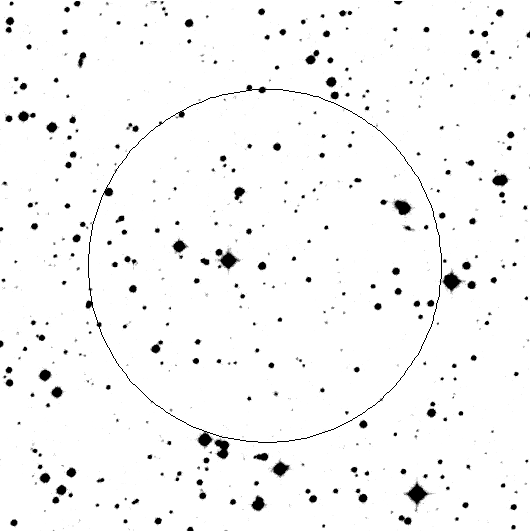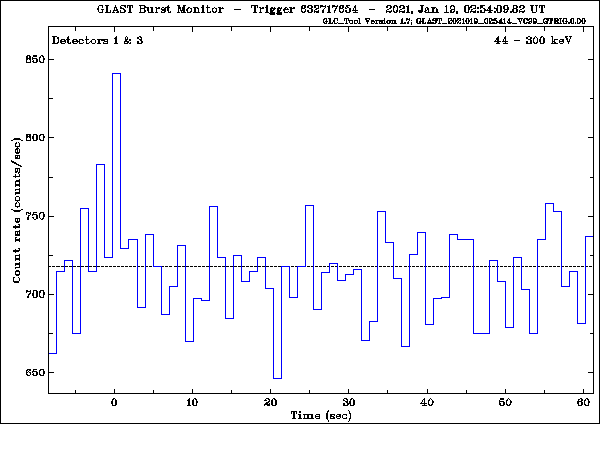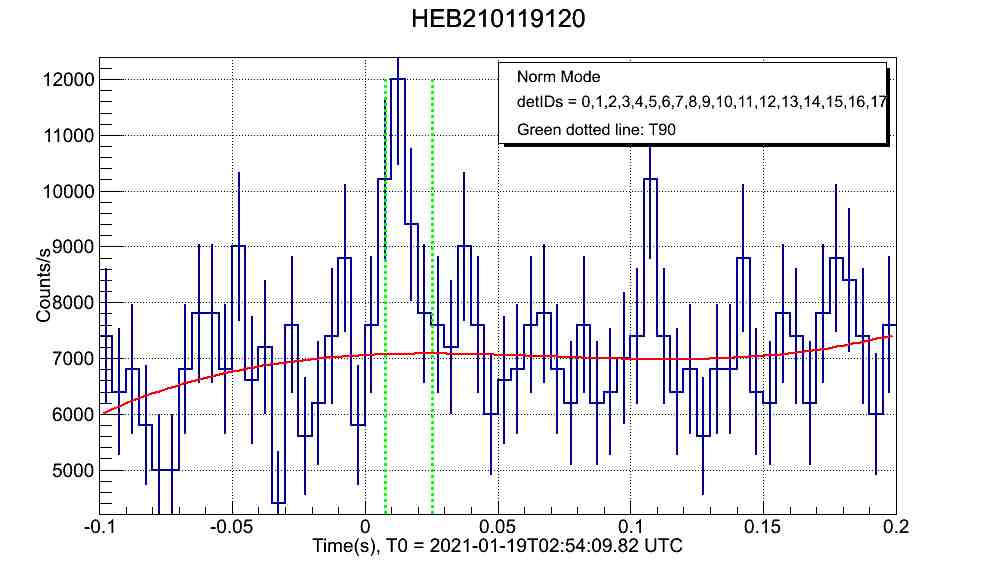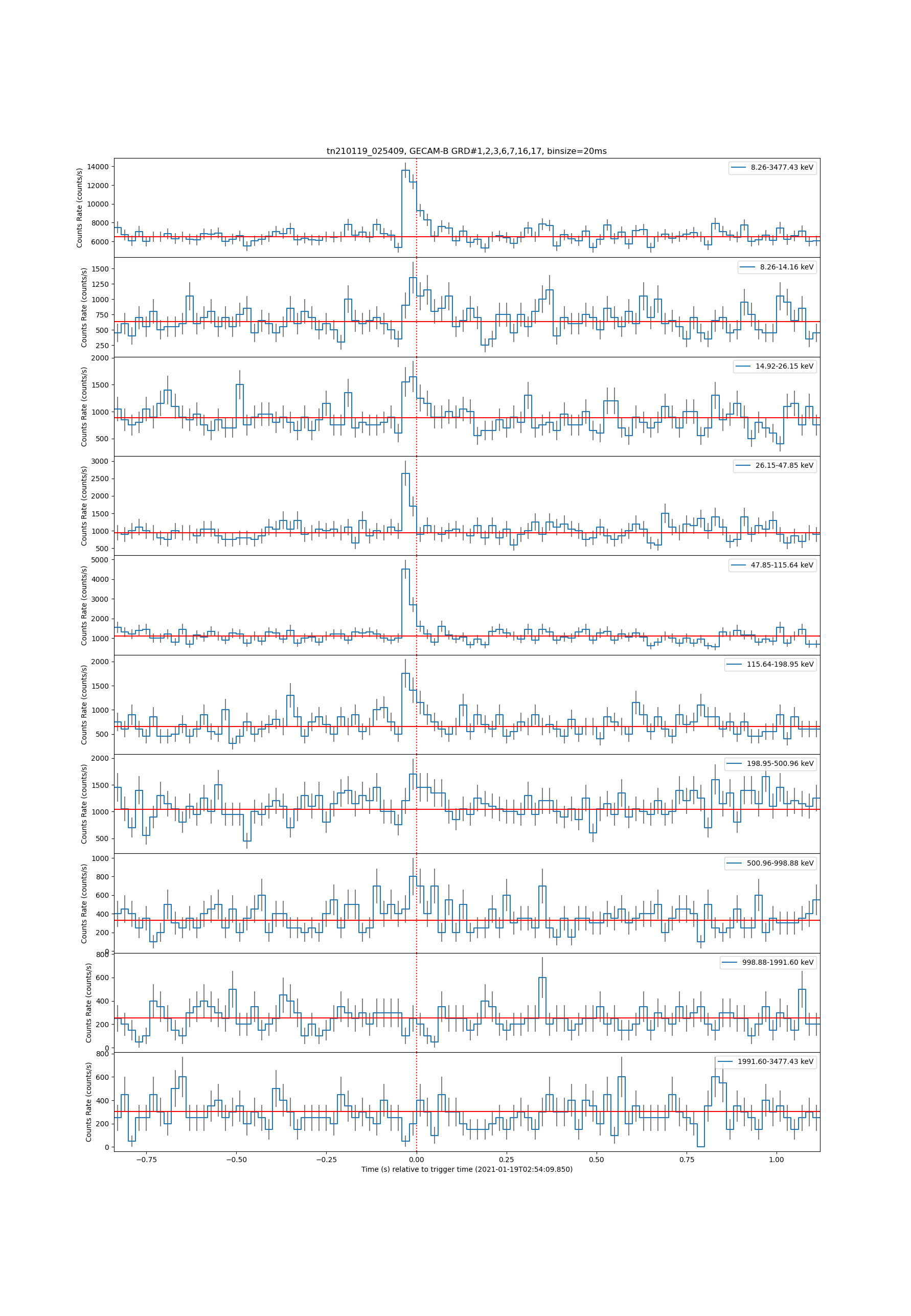- GCN/BACODINE POSITION NOTICE
TITLE: GCN/SWIFT NOTICE
NOTICE_DATE: Tue 19 Jan 21 02:54:29 UT
NOTICE_TYPE: Swift-BAT GRB Position
TRIGGER_NUM: 1017711, Seg_Num: 0
GRB_RA: 282.804d {+18h 51m 13s} (J2000),
283.287d {+18h 53m 09s} (current),
281.656d {+18h 46m 37s} (1950)
GRB_DEC: -61.801d {-61d 48' 02"} (J2000),
-61.774d {-61d 46' 26"} (current),
-61.860d {-61d 51' 34"} (1950)
GRB_ERROR: 3.00 [arcmin radius, statistical only]
GRB_INTEN: 505 [cnts] Image_Peak=109 [image_cnts]
TRIGGER_DUR: 0.032 [sec]
TRIGGER_INDEX: 10318 E_range: 25-100 keV
BKG_INTEN: 15838 [cnts]
BKG_TIME: 10437.64 SOD {02:53:57.64} UT
BKG_DUR: 8 [sec]
GRB_DATE: 19233 TJD; 19 DOY; 21/01/19
GRB_TIME: 10449.80 SOD {02:54:09.80} UT
GRB_PHI: -21.92 [deg]
GRB_THETA: 24.10 [deg]
SOLN_STATUS: 0x20000003
RATE_SIGNIF: 49.36 [sigma]
IMAGE_SIGNIF: 12.02 [sigma]
MERIT_PARAMS: +1 +0 +0 -5 +2 +1 -100 +0 -72 +0
SUN_POSTN: 301.40d {+20h 05m 36s} -20.30d {-20d 18' 16"}
SUN_DIST: 43.34 [deg] Sun_angle= 1.2 [hr] (West of Sun)
MOON_POSTN: 11.22d {+00h 44m 52s} -0.43d {-00d 25' 58"}
MOON_DIST: 88.64 [deg]
MOON_ILLUM: 34 [%]
GAL_COORDS: 333.99,-23.67 [deg] galactic lon,lat of the burst (or transient)
ECL_COORDS: 277.71,-38.70 [deg] ecliptic lon,lat of the burst (or transient)
COMMENTS: SWIFT-BAT GRB Coordinates.
COMMENTS: This is a rate trigger.
COMMENTS: A point_source was found.
COMMENTS: This does not match any source in the on-board catalog.
COMMENTS: This does not match any source in the ground catalog.
COMMENTS: This is a GRB.
COMMENTS: This trigger occurred at longitude,latitude = 121.50,-10.91 [deg].
COMMENTS:
COMMENTS: NOTE: This BAT event is temporally(0.0<100sec) coincident with the FERMI_GBM event (trignum=632717654).
- red DSS finding chart
ps-file

- GCN NOTICE
TITLE: GCN/FERMI NOTICE
NOTICE_DATE: Tue 19 Jan 21 02:54:34 UT
NOTICE_TYPE: Fermi-GBM Flight Position
RECORD_NUM: 50
TRIGGER_NUM: 632717654
GRB_RA: 289.117d {+19h 16m 28s} (J2000),
289.627d {+19h 18m 31s} (current),
287.899d {+19h 11m 36s} (1950)
GRB_DEC: -65.367d {-65d 22' 00"} (J2000),
-65.328d {-65d 19' 39"} (current),
-65.455d {-65d 27' 17"} (1950)
GRB_ERROR: 5.72 [deg radius, statistical plus systematic]
GRB_INTEN: 2151 [cnts/sec]
DATA_SIGNIF: 13.90 [sigma]
INTEG_TIME: 0.016 [sec]
GRB_DATE: 19233 TJD; 19 DOY; 21/01/19
GRB_TIME: 10449.82 SOD {02:54:09.82} UT
GRB_PHI: 0.00 [deg]
GRB_THETA: 5.00 [deg]
DATA_TIME_SCALE: 0.0160 [sec]
HARD_RATIO: 0.88
LOC_ALGORITHM: 3 (version number of)
MOST_LIKELY: 98% GRB
2nd_MOST_LIKELY: 1% Generic Transient
DETECTORS: 1,1,0, 1,0,0, 0,0,0, 0,0,0, 0,0,
SUN_POSTN: 301.40d {+20h 05m 36s} -20.30d {-20d 18' 16"}
SUN_DIST: 45.69 [deg] Sun_angle= 0.8 [hr] (West of Sun)
MOON_POSTN: 11.22d {+00h 44m 52s} -0.43d {-00d 25' 57"}
MOON_DIST: 86.11 [deg]
MOON_ILLUM: 34 [%]
GAL_COORDS: 330.66,-27.06 [deg] galactic lon,lat of the burst (or transient)
ECL_COORDS: 280.69,-42.64 [deg] ecliptic lon,lat of the burst (or transient)
LC_URL: http://heasarc.gsfc.nasa.gov/FTP/fermi/data/gbm/triggers/2021/bn210119121/quicklook/glg_lc_medres34_bn210119121.gif
COMMENTS: Fermi-GBM Flight-calculated Coordinates.
COMMENTS: This trigger occurred at longitude,latitude = 150.18,-22.82 [deg].
COMMENTS: The LC_URL file will not be created until ~15 min after the trigger.
COMMENTS:
COMMENTS: NOTE: This GBM event is temporally(0.0<100sec) coincident with the SWIFT_BAT event (trignum=1017711).
- GCN NOTICE
TITLE: GCN/FERMI NOTICE
NOTICE_DATE: Tue 19 Jan 21 02:54:55 UT
NOTICE_TYPE: Fermi-GBM Ground Position
RECORD_NUM: 60
TRIGGER_NUM: 632717654
GRB_RA: 290.390d {+19h 21m 34s} (J2000),
290.879d {+19h 23m 31s} (current),
289.224d {+19h 16m 54s} (1950)
GRB_DEC: -63.460d {-63d 27' 35"} (J2000),
-63.419d {-63d 25' 06"} (current),
-63.554d {-63d 33' 15"} (1950)
GRB_ERROR: 3.38 [deg radius, statistical only]
DATA_SIGNIF: 17.50 [sigma]
DATA_INTERVAL: 0.016 [sec]
GRB_DATE: 19233 TJD; 19 DOY; 21/01/19
GRB_TIME: 10449.82 SOD {02:54:09.82} UT
GRB_PHI: 0.00 [deg]
GRB_THETA: 7.00 [deg]
E_RANGE: 44.032 - 279.965 [keV]
LOC_ALGORITHM: 4173 (Gnd S/W Version number)
SUN_POSTN: 301.40d {+20h 05m 36s} -20.30d {-20d 18' 16"}
SUN_DIST: 43.70 [deg] Sun_angle= 0.7 [hr] (West of Sun)
MOON_POSTN: 11.22d {+00h 44m 53s} -0.43d {-00d 25' 52"}
MOON_DIST: 85.31 [deg]
MOON_ILLUM: 34 [%]
GAL_COORDS: 332.86,-27.39 [deg] galactic lon,lat of the burst (or transient)
ECL_COORDS: 281.88,-40.86 [deg] ecliptic lon,lat of the burst (or transient)
LC_URL: http://heasarc.gsfc.nasa.gov/FTP/fermi/data/gbm/triggers/2021/bn210119121/quicklook/glg_lc_medres34_bn210119121.gif
POS_MAP_URL: http://gcn.gsfc.nasa.gov/notices_f/gbm_gnd_loc_map_632717654.fits
COMMENTS: Fermi-GBM Ground-calculated Coordinates.
COMMENTS: In the LAT Field-of-view.
COMMENTS: Bright hard burst in the GBM.
COMMENTS: This Notice was ground-generated -- not flight-generated.
COMMENTS: The LC_URL file will not be created/available until ~15 min after the trigger.
COMMENTS: The POS_MAP_URL file will not be created/available until ~1.5 min after the notice.
COMMENTS:
COMMENTS: NOTE: This GBM event is temporally(0.0<100sec) coincident with the SWIFT_BAT event (trignum=1017711).
- GCN NOTICE
TITLE: GCN/FERMI NOTICE
NOTICE_DATE: Tue 19 Jan 21 03:03:36 UT
NOTICE_TYPE: Fermi-GBM Final Position
RECORD_NUM: 0
TRIGGER_NUM: 632717654
GRB_RA: 285.780d {+19h 03m 07s} (J2000),
286.272d {+19h 05m 05s} (current),
284.609d {+18h 58m 26s} (1950)
GRB_DEC: -63.120d {-63d 07' 11"} (J2000),
-63.088d {-63d 05' 15"} (current),
-63.193d {-63d 11' 34"} (1950)
GRB_ERROR: 7.81 [deg radius, statistical only]
GRB_DATE: 19233 TJD; 19 DOY; 21/01/19
GRB_TIME: 10449.82 SOD {02:54:09.82} UT
GRB_PHI: 17.00 [deg]
GRB_THETA: 7.00 [deg]
E_RANGE: 44.032 - 279.965 [keV]
LOC_ALGORITHM: 41731 (Gnd S/W Version number)
SUN_POSTN: 301.41d {+20h 05m 37s} -20.30d {-20d 18' 11"}
SUN_DIST: 44.01 [deg] Sun_angle= 1.0 [hr] (West of Sun)
MOON_POSTN: 11.29d {+00h 45m 09s} -0.40d {-00d 24' 02"}
MOON_DIST: 87.39 [deg]
MOON_ILLUM: 34 [%]
GAL_COORDS: 332.89,-25.29 [deg] galactic lon,lat of the burst (or transient)
ECL_COORDS: 279.26,-40.19 [deg] ecliptic lon,lat of the burst (or transient)
LC_URL: http://heasarc.gsfc.nasa.gov/FTP/fermi/data/gbm/triggers/2021/bn210119121/quicklook/glg_lc_medres34_bn210119121.gif
LOC_URL: http://heasarc.gsfc.nasa.gov/FTP/fermi/data/gbm/triggers/2021/bn210119121/quicklook/glg_locplot_all_bn210119121.png
COMMENTS: Fermi-GBM Final Position.
COMMENTS: This Notice was ground-generated -- not flight-generated.
COMMENTS: The LC_URL file should be available by the time this FINAL notice is produced.
COMMENTS: This notice was generated completely by automated pipeline processing.
COMMENTS: This is likely a Short GRB.
COMMENTS:
COMMENTS: NOTE: This GBM event is temporally(0.0<100sec) coincident with the SWIFT_BAT event (trignum=1017711).
- GCN Circular #29322
The Fermi GBM team reports the detection of a likely SHORT GRB
At 02:54:09 UT on 19 Jan 2021, the Fermi Gamma-ray Burst Monitor (GBM) triggered and located GRB 210119A (trigger 632717654.819782 / 210119121).
The on-ground calculated location, using the Fermi GBM trigger data, is RA = 285.8, Dec = -63.1 (J2000 degrees, equivalent to J2000 19h 03m, -63d 06'), with a statistical uncertainty of 7.8 degrees.
The angle from the Fermi LAT boresight is 7.0 degrees.
The skymap can be found here:
https://heasarc.gsfc.nasa.gov/FTP/fermi/data/gbm/triggers/2021/bn210119121/quicklook/glg_skymap_all_bn210119121.png
The HEALPix FITS file, including the estimated localization systematic, can be found here:
https://heasarc.gsfc.nasa.gov/FTP/fermi/data/gbm/triggers/2021/bn210119121/quicklook/glg_healpix_all_bn210119121.fit
The GBM light curve can be found here:
https://heasarc.gsfc.nasa.gov/FTP/fermi/data/gbm/triggers/2021/bn210119121/quicklook/glg_lc_medres34_bn210119121.gif

- GCN Circular #29323
M. J. Moss (GWU), S. D. Barthelmy (GSFC), H. A. Krimm (NSF),
A. Y. Lien (GSFC/UMBC), K. L. Page (U Leicester) and
D. M. Palmer (LANL) report on behalf of the Neil Gehrels Swift
Observatory Team:
At 02:54:09 UT, the Swift Burst Alert Telescope (BAT) triggered and
located a short burst which would be either an unknown Soft Gamma
Repeater or GRB 210119A (trigger=1017711).
The BAT on-board calculated location is
RA, Dec 282.804, -61.801 which is
RA(J2000) = 18h 51m 13s
Dec(J2000) = -61d 48' 02"
with an uncertainty of 3 arcmin (radius, 90% containment, including
systematic uncertainty). The BAT light curve showed a single peak
structure with a duration of 0.128 sec or less. The peak count rate
was ~8000 counts/sec (15-350 keV), at ~0 sec after the trigger.
Due to a Sun observing constraint, Swift cannot slew to the BAT
position until 12:54 UT on 2021 January 26. There will thus be no XRT
or UVOT data for this trigger before this time.
Due to the short timescale of the peak and the location of the source
in the Galactic bulge (lat, lon = 333.99, -23.67) this event may be
from a previously unknown Soft Gamma Repeater, which we would name
SGR Swift J1851.2-6148 .
Burst Advocate for this burst is M. J. Moss (mikejmoss3 AT gmail.com).
Please contact the BA by email if you require additional information
regarding Swift followup of this burst. In extremely urgent cases, after
trying the Burst Advocate, you can contact the Swift PI by phone (see
Swift TOO web site for information: http://www.swift.psu.edu/)
- GCN Circular #29324
V. Lipunov, E. Gorbovskoy, V.Kornilov, N.Tyurina, P.Balanutsa, A.Kuznetsov, F.Balakin,
V.Vladimirov, D. Vlasenko, I.Gorbunov, D.Zimnukhov, V.Senik, T.Pogrosheva,
D.Kuvshinov, D. Cheryasov
(Lomonosov Moscow State University, SAI, Physics Department),
R. Podesta, C.Lopez, F. Podesta, C.Francile
(Observatorio Astronomico Felix Aguilar OAFA),
R. Rebolo, M. Serra
(The Instituto de Astrofisica de Canarias),
D. Buckley
(South African Astronomical Observatory),
O.A. Gres, N.M. Budnev, O.Ershova
(Irkutsk State University, API),
A. Tlatov, D. Dormidontov
(Kislovodsk Solar Station of the Pulkovo Observatory),
V. Yurkov, A. Gabovich, Yu. Sergienko
(Blagoveschensk Educational State University)
MASTER-SAAO robotic telescope (Global MASTER-Net: http://observ.pereplet.ru, Lipunov et al., 2010, Advances in Astronomy, vol. 2010, 30L) located in South Africa (South African Astronomical Observatory) started inspect of the Fermi GRB 210119A ( Fermi GBM team, GCN 29322) errorbox 45 sec after trigger time at 2021-01-19 02:54:54 UT, with upper limit up to 15.1 mag. Observations started at twilight. The observations began at zenith distance = 65 deg. The sun altitude is -11.3 deg.
MASTER-OAFA robotic telescope located in Argentina (OAFA observatory of San Juan National University) started inspect of the Fermi GRB 210119A errorbox 57 sec after notice time and 108 sec after trigger time at 2021-01-19 02:55:58 UT, with upper limit up to 12.2 mag. The observations began at zenith distance = 84 deg. The sun altitude is -32.3 deg.
The galactic latitude b = -26 deg., longitude l = 333 deg.
Real time updated cover map and OT discovered available here:
https://master.sai.msu.ru/site/master2/observ.php?id=1529080
We obtain a following upper limits.
Tmid-T0 | Date Time | Site | Coord (J2000) |Filt.| Expt. | Limit| Comment
_________|_____________________|_____________________|____________________________________|_____|_______|_______|________
50 | 2021-01-19 02:54:54 | MASTER-SAAO | (18h 32m 27.92s , -60d 49m 23.7s) | P\ | 10 | 15.1 |
79 | 2021-01-19 02:55:24 | MASTER-SAAO | (18h 32m 30.98s , -60d 47m 57.6s) | P\ | 10 | 15.0 |
114 | 2021-01-19 02:55:53 | MASTER-SAAO | (18h 32m 25.77s , -60d 48m 47.0s) | P\ | 20 | 15.1 |
119 | 2021-01-19 02:55:58 | MASTER-OAFA | (19h 56m 18.53s , -62d 36m 50.8s) | C | 20 | 12.3 |
158 | 2021-01-19 02:56:33 | MASTER-SAAO | (18h 32m 25.96s , -60d 47m 45.1s) | P\ | 30 | 15.0 |
Filter C is a clear (unfiltred) band.
The observation and reduction will continue.
The message may be cited.
- GCN Circular #29325
N.Tiurina, V. Lipunov, V.Kornilov, E.Gorbovskoy, P.Balanutsa,F.Balakin,
V.Vladimirov, A.Kuznetsov,K.Zhirkov,D. Vlasenko, I.Gorbunov, D.Zimnukhov,
V.Senik, A.Chasovnikov,A.Pozdnyakov,V.Topolev, D.Cheryasov(Lomonosov
Moscow State University, SAI, Physics Department),
R. Podesta, C.Lopez, F. Podesta, C.Francile (Observatorio Astronomico
Felix Aguilar, San Huan National University),
R. Rebolo, M. Serra(The Instituto de Astrofisica de Canarias),
D. Buckley (South African Astronomical Observatory),
O.A. Gres, N.M. Budnev (Irkutsk State University, API),
A. Tlatov, D. Dormidontov (Kislovodsk Solar Station of the Pulkovo
Observatory),
A. Gabovich, V.Yurkov, Yu. Sergienko (Blagoveschensk Educational
StateUniversity)
MASTER-OAFA robotic telescope located in Argentina (OAFA observatory of
San Juan National University) started inspect of the Fermi GRB 210119A
errorbox 57 sec after notice time and 108 sec after trigger time at
2021-01-19 02:55:58 UT (Lipunov et al., GCN #29324). MASTER autodetection
system found short OT on one of unfiltered image.
Date/Time UT RA Dec Exp mag
2021-01-19 04:20:32 18h 51m 11.42s -61d 48m 06s.3 180s ~17
Error is ~1" .
The message may be cited.
- GCN Circular #29328
J.Mangan (UCD), R.Dunwoody (UCD), S. Lesage (UAH), C. Meegan (UAH)
report on behalf of the Fermi GBM Team:
At 02:54:09.82 UT on 19 January 2021, the Fermi Gamma-Ray Burst
Monitor (GBM) triggered and located GRB 210119A (trigger 632717654 /
210119.121),
which was also detected by the Swift/BAT (M. J. Moss et al. 2021, GCN
29323). The Fermi GBM Final Real-time Localization (GCN 29322) is
consistent with the Swift position.
The angle from the Fermi LAT boresight at the GBM trigger time is 8 deg degrees.
The GBM light curve consists of a short bright burst
with a duration (T90) of about 0.05 s (50-300 keV).
The time-averaged spectrum from T0-0.064 s to T0+0.064 s is
best fit by a power law function with an exponential
high-energy cutoff. The power law index is -0.82 +/- 0.18 and
the cutoff energy, parameterized as Epeak, is 515 +/- 168 keV.
Unlikely to be an SGR given Epeak result. The event fluence (10-1000
keV) in this time interval is
(3.432 +/- 0.397)E-7 erg/cm^2. The 64-ms peak photon flux measured
starting from T0-0.064 s in the 10-1000 keV band
is 11.7 +/- 1.3 ph/s/cm^2.
The spectral analysis results presented above are preliminary;
final results will be published in the GBM GRB Catalog:
https://heasarc.gsfc.nasa.gov/W3Browse/fermi/fermigbrst.htmlFor Fermi
GBM data and info, please visit the official Fermi GBM Support Page:
https://fermi.gsfc.nasa.gov/ssc/data/access/gbm/"
- GCN Circular #29329
Q. B. Yi, S. Xiao, Q. Luo, C. Cai, C. K. Li, X. B. Li, G. Li, J. Y. Liao, S=
=2E L. Xiong, C. Z. Liu, X. F. Li, Z. W. Li, Z. Chang, X. F. Lu, A. M. Zhan=
g, Y. F. Zhang, C. L. Zou (IHEP), Y. J. Jin, Z. Zhang (THU), T. P. Li (IHEP=
/THU), F. J. Lu, L. M. Song, M. Wu, Y. P. Xu, S. N. Zhang (IHEP), report on=
behalf of the Insight-HXMT team: At 2021-01-19T02:54:09.82 (T0), Insight-H=
XMT/HE detected GRB 210119A (trigger ID: HEB210119120) in a routine search =
of the data, which was also triggered by Fermi/GBM (GCN #29322) and Swift/B=
AT (M. J. Moss. et al., GCN #29323). The Insight-HXMT/HE light curve mainly=
consists of a single =A0 pulse with a duration (T90) of 0.03 s measured fr=
om T0+0.01 s. The 1-ms peak rate, measured from T0+0.004 s, is 4418 cnts/se=
c. The total counts from this burst is 62 counts. URL_LC: http://twiki.ihep=
=2Eac.cn/pub/HXMT/GRBList/HEB210119120_lc.jpg All measurements above are ma=
de with the CsI detectors operating in the regular mode with the energy ran=
ge of about 80-800 keV (deposited energy). Only gamma-rays with energy grea=
ter than about 200 keV can penetrate the spacecraft and leave signals in th=
e CsI detectors installed inside of the telescope. Insight-HXMT is the firs=
t Chinese space X-ray telescope, which was funded jointly by the China Nati=
onal Space Administration (CNSA) and the Chinese Academy of Sciences (CAS).=
More information about it could be found at: http://www.hxmt.org.

- GCN Circular #29331
Z. H. An, C. Cai, G. Chen, W. Chen, M. Gao, M. Y. Ge, K. Gong, D. Y. Guo,
J. J. He, Y. Huang, B. Li, C. Li, C. Y. Li, J. H. Li, M. S. Li, L. X. Li,
X. B. Li, X. Q. Li, Y. G. Li, X. H. Liang, J.C. Liu, X. J. Liu, Y. Q. Liu,
F. J. Lu, Q. Luo, X. Ma, G. Ou, W. X. Peng, R. Qiao, J. Y. Shi, D. L. Shi,
L. M. Song, X. Y. Song, G. X. Sun, X. L. Sun, Y. L. Tuo, J. Z. Wang,
C. W. Wang, P. Wang, W. S. Wang, X. Y. Wen, S. Xiao, S. L. Xiong, Y. B. Xu,
Y. P. Xu, W. C. Xue, S. Yang, M. Yao, Q. B. Yi, K. Zhang, P. Zhang,
D. L. Zhang, F. Zhang, H. M. Zhang, S. N. Zhang, Y. Q. Zhang, Z. Zhang,
S. Y. Zhao, X. Y. Zhao, Y. Zhao, C. Zheng, S. J. Zheng (IHEP), L. Chang,
Y. M. Chen, X. B. Han, J. Huang, J. P. Yu, K. K. Zhang (IAMCAS), L. Chen,
H. Geng, T. Hu, T. Jing, B. Q. Li, F. L. Ma, X. Meng, H. Y. Wu, J. Wu,
Z. G. Xiao, W. Zhang, Z. M. Zou (NSSC), K. Feng, Y. M. Zhang (AIR),
(The GECAM Mission Team) report:
During the commissioning phase, one satellite of GECAM mission, GECAM-B,
was triggered by a short GRB 210119A or a new SGR candidate
Swift J1851.2-6148 at 2021-01-19T02:54:09.850 (T0).
This burst was also observed by Fermi/GBM (GCN #29322), Swift/BAT
(GCN #29323) and Insight-HXMT (GCN #29329).
According to the GECAM-B light curves in about 8 keV-4 MeV,
this burst consists of a single pulse with a duration (T90) of
38.03 +/- 0.62 ms. The 20-ms peak counts rate is about 7000 cps while the
total counts is about 360 counts. A prominent spectral variation across
the burst duration is evident especially below 25 keV. The spectral
hardness measured by GECAM-B suggests that this bust is more likely
a short GRB rather than a typical SGR.
The GECAM light curve could be found here:
http://twiki.ihep.ac.cn/pub/GECAM/GRBList/GECAM-B-tn210119_025409.png
Although the in-flight calibration of energy response and localization
has not been finalized yet, and this burst is rather short and weak,
GECAM-B localized this burst to the following position (J2000):
ra: 284.3 deg
dec: -60.4 deg
err: 6.4 deg
which is consistent with the position given by Swift/BAT within the error.
Please note that all GECAM results here are preliminary. The final
analysis will be published in journal papers or GECAM online catalog.
This is the first published burst detected by GECAM mission.
Gravitational wave high-energy Electromagnetic Counterpart All-sky Monitor
(GECAM) mission consists of two small satellites (GECAM-A and GECAM-B) in
Low Earth Orbit (600 km, 29 deg), launched on Dec 10, 2020 (Beijing Time),
which was funded by the Chinese Academy of Sciences (CAS).

- GCN Circular #29332
T. N. Ukwatta (LANL), S. D. Barthelmy (GSFC), H. A. Krimm (NSF),
S. Laha (GSFC/UMBC), M. J. Moss (GWU), A. Y. Lien (GSFC/UMBC),
C. B. Markwardt (GSFC), D. M. Palmer (LANL), T. Sakamoto (AGU),
M. Stamatikos (OSU), (i.e. the Swift-BAT team):
Using the data set from T-239 to T+963 sec from the recent telemetry downlink,
we report further analysis of Swift/BAT trigger #1017711
(Moss, et al., GCN Circ. 29323). The BAT ground-calculated position is
RA, Dec = 282.822, -61.767 deg which is
RA(J2000) = 18h 51m 17.4s
Dec(J2000) = -61d 45' 59.7"
with an uncertainty of 1.5 arcmin, (radius, sys+stat, 90% containment).
The partial coding was 92%.
The mask-weighted light curve shows a single spike with a FRED-like shape,
rising sharply at T+0 sec and decaying to background by T+0.1 sec.
T90 (15-350 keV) is 0.06 +- 0.02 sec (estimated error including systematics).
The time-averaged spectrum from T+0.00 to T+0.08 sec is best fit by a simple
power-law model. The power law index of the time-averaged spectrum is
1.41 +- 0.22. The fluence in the 15-150 keV band is 7.1 +- 0.9 x 10^-8 erg/cm2.
The 1-sec peak photon flux measured from T-0.46 sec in the 15-150 keV band
is 1.0 +- 0.2 ph/cm2/sec. All the quoted errors are at the 90% confidence
level.
In the original GCN circular, it was discussed that this event could be either a
previously unknown Soft Gamma Repeater (Swift J1851.2-6148) or short GRB 210119A.
While the BAT data alone is insufficient for us to make a definitive judgement as to the
nature of the source, our assessment of these data suggests that the event was more
likely a short GRB for the following reasons. First, the spectrum is rather hard, and the
position of the burst on the T90-hardness diagram is within the population of short GRBs.
Second, the light curve shows a FRED (fast rise, exponential decay) profile, more
consistent with a GRB than with an SGR flare. Third, the event location is 35 degrees
away from the center of the galactic bulge.
The results of the batgrbproduct analysis are available at
http://gcn.gsfc.nasa.gov/notices_s/01017711000/BA/
![]() Previous IAU Circulars
Previous IAU Circulars 


